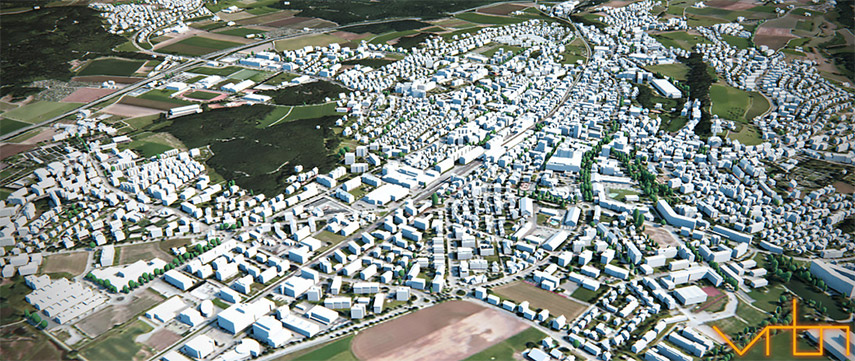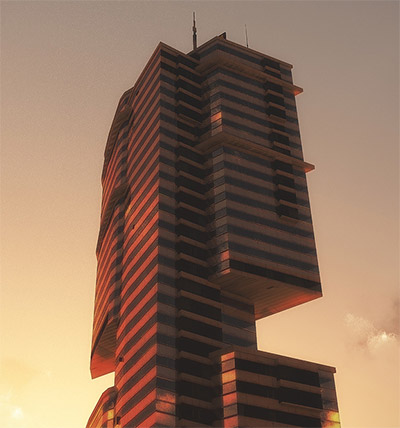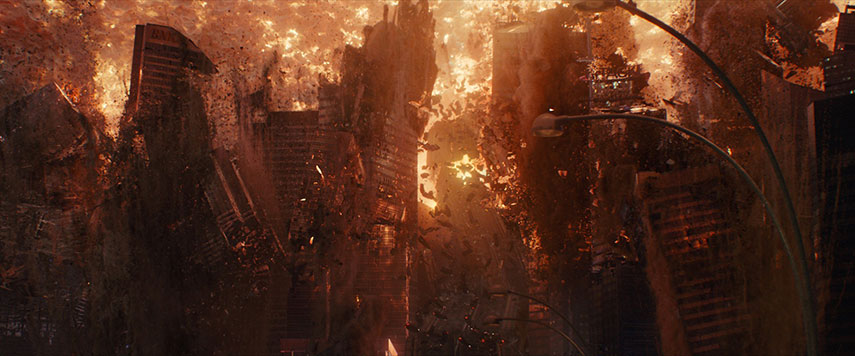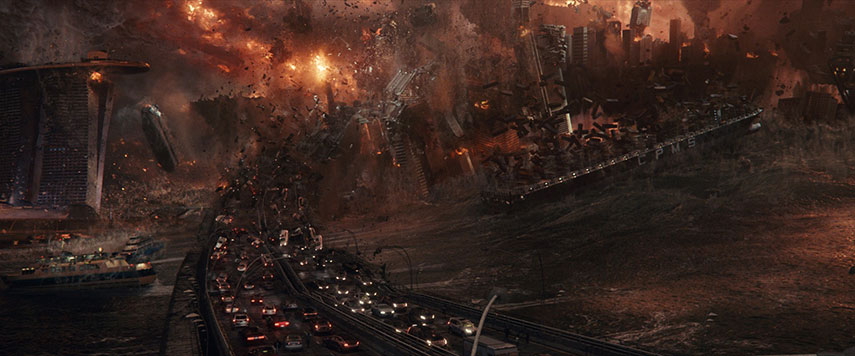Matthias Buehler

GW: Hi Matthias! Tell us how you became one of the rare specialists in CityEngine? How did it all start for you?
MB: Well, passion, some luck, and a lot of hard work. After I had graduated University with my Master's degree in Architecture in 2007, I worked for some time in landscape architecture. But the voices in my head told me I should pursue my passions rather than staying in 'classic architecture.' So I decided to spend half a year at Gnomon in Hollywood. During this time, I contacted Pascal Mueller, the mastermind behind CityEngine. I met him for the first time at SIGGRAPH 2008, in Los Angeles. The young startup company behind Procedural Inc. had been founded not long before. They were demonstrating their part in the 'Rome Reborn' project. When I returned to Switzerland, I first worked in architectural visualization, but then, in October 2009 – almost a year later, and Procedural having sorted some startup finances – I got a job with them! Three years later, Procedural Inc. was acquired by Esri. I continued to work on the team for almost two more years before I decided to leave product engineering and move into the artist/user role – as a CityEngine consultant.

GW: How do you feel your background in architecture helps with your ability to visualize and create digital film sets?
MB: For my specific job, it's immensely helpful. If you dedicate your life to studying something for six years and combine this knowledge with something you love, you not only develop a certain expertise, but also a deep appreciation for the details. Details matter – and they are a challenge! The main thing when creating believable architecture is that the constructional details need to be just right: dimensions, material thicknesses, volume ratio, patterns and rhythms, and so on. Buildings have mass, they oppose gravity, they develop a 'patina' over time, and they typically don't have flying parts or look like uninhabitable sculptures.
GW: What are the first steps that you take when translating concept art into a 3D environment for a visual effects project?
MB: I see concept art for environments as just a 'glimpse' into a whole other world. I never take it literally, only as inspiration. I think this is a very important fact and the lesson I have learned during my studies. Other people read, interpret, and judge images differently than we do. Time is precious. Therefore it's crucial to remove potential misunderstandings early on. I believe that concept art for characters or objects is supposed to transport an 'explicit' definition: specific look, size, materials, ratios, etc. While concept art for environments – especially urban – is supposed to transport an 'implicit' definition: mood, elements, weather conditions, social conditions, architectural styles, and so on, that first needs interpreting. Therefore, the first step for me is compiling a list of questions that give me solid indicators, which components of the story told will, in the end, have to be represented as programmatical attribution, to drive the urban context, density, architectural styles and so on. In the end, I'm just well-trained in listening, observing, finding patterns, and architectural semantics – and then translate everything into machine code.

GW: As well as CityEngine, what are the other tools that are essential to your work, and how does knowledge of scripting help create more impressive cityscapes?
MB: Personally, I don't need a lot more than my Wacom and tablet, an old 3DConnexion Space Pilot, Google Image search, Photoshop, NotePad++, Maya, and any renderer. As with everything else, I try to work as procedurally as possible. Therefore, I also try to avoid complex compositing in all-CG environments. If colors are off, I prefer to fix the source texture than doing it in post, where every different lighting condition enforces separate fine-tuning. Scripting allows me to be lazy and automate repetitive tasks. But it also allows for creative workflows across tools that nobody else uses. I do a lot of hobby R&D, just trying to figure out new ideas and workflows. Many of the things I have discovered like this have become regular parts of my workflows. Some of the stuff is unorthodox, sure, but it gets the job done! Also, scripting sharpens your mind: you have to absolutely understand every single step and line of code to reach your goal. Sometimes you win, and it works; sometimes you lose and you have to start from scratch. As Lemmy used to sing: 'You win some, lose some, it's all the same to me.'

GW: What are your favorite tools for rendering your incredible 3D environments, and why?
MB: My favorite combo is CityEngine, Maya, and Maxwell Render – all these tools support Python scripting, which allows for powerful workflows. Maxwell is itself a piece of art: Easy to learn, stable like a rock, no settings to tweak, and in my opinion: the best image quality in the industry. It's as simple as that. I'm also investing time in learning Houdini, since my workflows get more and more technical and the ideas I have for future in-house tools either need the framework flexibility that Houdini provides – or that I develop everything from scratch.
GW: As Lead Environment Developer on Independence Day: Resurgence at Scanline VFX in Vancouver, what were some of the challenges of that position?
MB: The first challenge was that I had never worked in VFX before. The second was the pressure to prove that 'this CityEngine thingy’ will work; I had to propose the complete workflow to the VFX Supervisor, Mohsen Mousavi, and implement it together with the pipeline developers. Challenge number three was being in a Lead position – introducing artists to procedural workflows for asset and texture creation, managing resources, time, and lots of technical tickets. The fourth challenge was to use the new system to make up the time that multiple artists were reassigned to do other things than working on environments. The fifth was that the system and its documentation needed to be easy enough for other artists to pick up during production for other upcoming movies after Independence Day: Resurgence. These were of course just a few of the challenges, but I guess they pretty clearly show the huge responsibilities involved.

Copyright © 2016 20th Century Fox
GW: Can you explain why procedural modeling with CityEngine was the best solution for the scenes of mass destruction in Independence Day: Resurgence?
MB: For design tasks, where repetition is key, a procedural methodology usually proves to be more efficient than manual labor. And most types of architectures are notoriously ‘boxy and repetitive.' The downside is the setup time and a very technical nature of the workflow. The upside is that, once it’s set up, it doesn’t really matter if you generate 5,000 or 500,000 buildings, as the environment creation process is reduced to only driving the design of the urban layout, while the system models the geometries for you according to the archetypes defined in the rules.
GW: Are you able to share what a typical day at Scanline VFX in Vancouver was like?
MB: Well, typically, it was a rainy day, with the first official act being to grab an espresso at my favorite coffee shop in Vancouver: Buzz Café. At Scanline VFX, environments are created as a collaboration between multiple departments, so the first emails and discussions were about tracking technical issues down or regarding open tickets or features requests. The tickets I had organized under categories – with tons of yellow post-it notes on the glass wall next to my desk. So, often I was just standing there, shuffling them around and prioritizing. Next were quick meetings with modelers or generalists that were helping with creating texture sets or specific assets that were needed. After lunch, we had either look-dev or layout dailies, with additional input from the VFX Supervisor. The rest of the day I would spend either developing the CityEngine rule sets, improving the implementation of the custom export process, or working on actual environment design iterations.

Copyright © 2016 20th Century Fox
GW: What about your side projects – can you tell us about those?
MB: Well, time is precious, but indeed I'm trying hard to keep doing side projects. Recently, I have created a digital painting of an angel for my friend Cyrill Oberhaensli's entirely self-developed indie game Like Clay. The next collaboration is already starting with my other friend, Pascal Heinzelmann, who is an aspiring and super-talented concept artist. This collaboration will, of course, have to do with environments!
GW: Can you recall some of the obstacles you faced when first learning 3D tools, and what advice do you have to aspiring 3D environment artists?
MB: The first and biggest issue was the availability and price of the tools. I started in 1992 on Mac OS, with Adobe Dimensions. Later on, I played with demo versions from computer magazine CDs (Electric Image, Strata Studio Pro), before I started using Cinema4D 3.0, and eventually jumped to LightWave 5.0. The other issue was the utter non-existence of any potential jobs in this field – in almost all of Europe. These times are long gone. Now we have other challenges!
To be able to create a believable environment, we have to understand it's 'entropy.' Everything is 'noise.' And we have to understand its statistics; to be able to transcend into the worlds we create. I typically do this by simply staring at reference photos for hours: counting details, finding patterns, repetitive elements, materials, and color palettes. Everything is connected, and it's all about finding the essential rules that make up the system.
My advice may be a bit uncommon. I recommend studying reference imagery and literally counting and listing all the different elements you can find: how often they appear, how they are clustered and how the overall color mix is connected to the mood. Then, reduce to the max: remove everything that appears less than 10-percent, or does not fit the mood. Finally, and most importantly, jump down the rabbit hole: discover what life would actually be like there; invent your own stories of imaginary inhabitants.

Copyright © 2016 20th Century Fox
GW: Since leaving your role at Scanline VFX, you’ve founded your own company, vrbn. Can you tell us what led you to start up your own studio, and what are vrbn’s core areas of expertise?
MB: It was my dream for quite some time to have something studio-like, dedicated to 3D environments. I'm more into backgrounds and static environments that set the stage for other artists’ stories, so 3D architecture, cities, and environments are my favorites. What The Third Floor is for pre-viz, I want vrbn to become for 3d environment services. The main focus will be on real-world applications: procedural city-planning (layout, statistics, design), with a strong component of visualization technologies: offline/real-time rendering, and VR. Plus – and this is very rare – custom CityEngine rule development. Next to that, I would of course like to collaborate with VFX studios.
GW: You mentioned you attended Gnomon – School of Visual Effects, Games + Animation for a while – how did Gnomon help you step up your game? Coming from Switzerland, what was it like living in and adapting to Los Angeles?
MB: Gnomon was a great experience back in 2008. I'd say it was the perfect timing for me to leave my little country and see something completely different. Traveling and living in other cultures is one of the best things you can do in life in general, as it opens up your mind and forces you to leave your comfort zone over and over again. What I especially liked was the whole groove on campus: to be among motivated, enormously talented students, that all came to this one place, based on common interests. Next to gaining insight into new tools like Massive, Boujou or Shake – rest in peace – Gnomon helped me to gain a much better understanding of creative processes, work methodology, and interdisciplinary collaboration.

Copyright © 2016 20th Century Fox
GW: You contributed to the CityEngine software development for several years. Can you share with us some of your proudest contributions to the development of CityEngine?
MB: As I’m not a developer, my contributions were more in the content, support, training, and product engineering side of things. There were countless proud contributions, but what stood out to me most were being able to provide feature and usability inputs, helping clients via the forums and conferences, and seeing the progress and success of the countless people I have trained. One other component that indirectly pushed the tool were my hobby projects, which are still among the most complex and visually strongest CityEngine projects out there, next to the applications of the tool in feature films like Cars 2, Man of Steel, Big Hero 6, Total Recall, and of course again some of my own work again at Scanline VFX, on Independence Day: Resurgence.
GW: You’ve presented workshops around the world – what are some of the most frequently asked questions you hear?
MB: The most common question is probably: Are the rule sets available for all major cities? This refers to the procedural nature of CityEngine, as it works with procedural rules to create the city models. The truth is that most CityEngine users have very specific needs, which makes it almost impossible to prefabricate rules for all those applications. This is, of course, a potential of vrbn. Another very common one is: Can CityEngine design for me based on target statistics? Well, if that were the case, would we need any more planners or architects in this world? The short answer is that CityEngine is currently the tool that allows the fastest design iterations for urban environments, with precise reporting of key statistics. It's the user that has to define the design language, while the tool provides a powerful framework to create and control the geometries and variations thereof.
GW: Tell us about your latest Gnomon Workshop training, CityEngine in VFX. What can the viewer expect to learn, and what new skills will they walk away with after the seven-hour training project?
MB: This training is a great introduction to CityEngine for beginners and a source of inspiration for already advanced users. All the key concepts are explained in detail to help you get started fast. This also includes CGA, CityEngine's proprietary scripting language that is used to create the models. Furthermore, multiple approaches are discussed that explain how certain components of laying out large-scale urban environments can be translated into CGA code. And, as we're also working on an example urban environment, a simple render workflow is proposed that cleanly ports material and instancing information to Maya, ready to render with Maxwell Render.
| Check out CityEngine in VFX, Shot Based Approach To High Quality Procedural Film Sets with Matthias Buehler |






